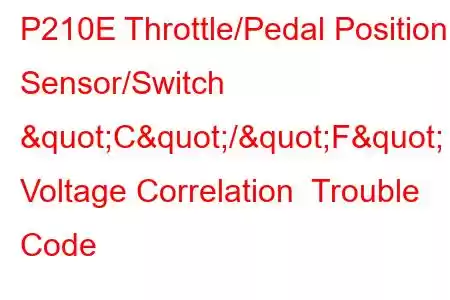P210E Throttle/Pedal Pos Sensor C/F Voltage Correlation
OBD-II Trouble Code Technical Description
Throttle/Pedal Pos Sensor/Switch C / F Voltage Correlation
What does that mean?
This diagnostic trouble code (DTC) is a generic powertrain code. It is considered generic because it applies to all makes and models of vehicles (1996-newer), although specific repair steps may be slightly different depending on the model.
The automotive trouble code P210E throttle/pedal position sensor/switch C/F voltage correlation refers to a problem related to the throttle's ability to open and close properly.
In the 1990's automotive manufacturers began industry-wide installation of "Drive by wire" throttle control technology. It's mission is to afford greater control over the emissions, fuel economy, traction and stability control, cruise control and transmission responses.
Prior to this, the vehicle's throttle was controlled by a simple cable with a direct connection between the gas pedal and the throttle. A throttle position sensor (TPS) is situated opposite the throttle linkage connection on the throttle plate. The TPS converts throttle movement and position to a voltage signal and sends it to the engine management computer, which uses the varying voltage signal to form engine management strategy.
The new "electronic throttle control" technology consists of a accelerator pedal position sensor, an electronically controlled throttle body complete with an internal motor, two embedded throttle position sensors for correlation factors and the engine management computer.
Although the code has the same frame of reference, it is worded slightly different on some brands, such as "Throttle position sensor circuit range/performance" on an Infiniti or "Electronic throttle control system malfunction power management" on a Hyundai.
When you depress the accelerator pedal you are pushing down on a sensor indicating the desired amount of throttle opening which is sent to the engine management computer. In response the computer sends a voltage to the electric motor to open the throttle plate. Two throttle position sensors imbedded in the throttle body convert the amount of throttle opening to a voltage signal to the computer.
Photo of a throttle body, throttle body position (TPS) sensor is the black part to the lower right:
The computer monitors the correlation of both voltages. When both voltages agree, the system is functioning properly. When they deviate for two seconds, the code P210E is set indicating a malfunction somewhere in the system. Additional trouble codes may accompany this code which further identify the problem. The bottom line is, it can be a dangerous situation when control over the throttle is lost.
Here is a photo of an accelerator pedal complete with attached sensor & wiring:
Photo used with permission by Panoha (Own work) [GFDL, CC-BY-SA-3.0 or FAL], via Wikimedia Commons
NOTE: This P210E DTC is basically the same as P2135, P2136, P2137, P2138, P2139, and P2140, diagnostic steps will be the same for all codes.
Symptoms
Symptoms of a P210E code can range from stalling when you come to a stop, total lack of power, no acceleration, sudden loss of power at cruise speeds or stuck throttle at current rpm. Additionally, the check engine light will illuminate and the code will be set.
Potential Causes of P210E DTC
It's been my experience that the wiring connector or "pig tail" on the throttle body gives problems in the form of a poor connection.The female terminals on the pigtail corrode or pull out of the connector. Possible bare wire on pigtail shorting to ground. The top cover on the throttle body distorted preventing the gears from turning properly. The electronic throttle body is faulRead: 24


